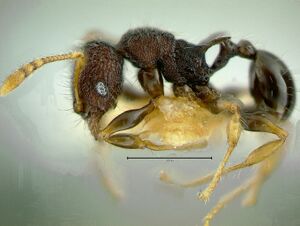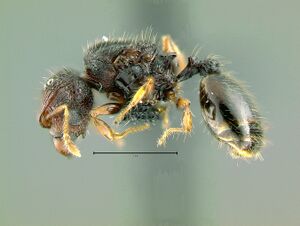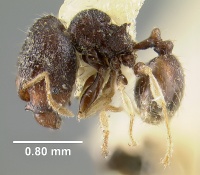Pheidole fantasia
| Pheidole fantasia | |
|---|---|

| |
| Scientific classification | |
| Kingdom: | Animalia |
| Phylum: | Arthropoda |
| Class: | Insecta |
| Order: | Hymenoptera |
| Family: | Formicidae |
| Subfamily: | Myrmicinae |
| Tribe: | Attini |
| Genus: | Pheidole |
| Species: | P. fantasia |
| Binomial name | |
| Pheidole fantasia Chapman, 1963 | |
This species seems to inhabit well-developed lowland forests. (Eguchi 2001)
Identification
Eguchi (2001) - This species is easily recognised among Bornean Pheidole in its peculiar shape of head of the major, and ivory-white tibiae and tarsi in both the subcastes. The only difference between this and the closest undescribed relative, P. sp. eg-90 (Padang, W. Sumatra, FI97-451), is unicolored legs in the latter.
The type material of P. fantasia is very similar to the specimens from Borneo, but the following differences are noticed: in the type material promesonotum of the minor with a pair of very low tubercles dorsolaterally; propodeal spines of the major much longer; petiolar node, postpetiole and gaster of the minor also ivory-white; anterior part of frons (between frontal lobes) of the major rugose, with punctured interspaces; head of the major shorter (CI 94-96). However, I tentatively treat the Bornean population as P. fantasia until additional specimens from various localities become available.
Keys including this Species
- Key to Pheidole majors and minors of Borneo
- Key to Pheidole majors of Borneo
- Key to Pheidole minors of Borneo
Distribution
Latitudinal Distribution Pattern
Latitudinal Range: 10° to 10°.
| North Temperate |
North Subtropical |
Tropical | South Subtropical |
South Temperate |
- Source: AntMaps
Distribution based on Regional Taxon Lists
Indo-Australian Region: Borneo, Indonesia, Malaysia, Philippines (type locality).
Distribution based on AntMaps
Distribution based on AntWeb specimens
Check data from AntWeb
Countries Occupied
| Number of countries occupied by this species based on AntWiki Regional Taxon Lists. In general, fewer countries occupied indicates a narrower range, while more countries indicates a more widespread species. |

|
Estimated Abundance
| Relative abundance based on number of AntMaps records per species (this species within the purple bar). Fewer records (to the left) indicates a less abundant/encountered species while more records (to the right) indicates more abundant/encountered species. |

|
Biology
Castes
Worker
Minor
  
| |
| . | |
Major
  
| |
| . | |
Queen
  
| |
| . | |
Nomenclature
The following information is derived from Barry Bolton's Online Catalogue of the Ants of the World.
- fantasia. Pheidole fantasia Chapman, 1963: 255, fig. 6 (s.w.q.) PHILIPPINES. See also: Eguchi, 2001b: 51.
Unless otherwise noted the text for the remainder of this section is reported from the publication that includes the original description.
Description
Worker
Eguchi (2001) - Major (n=2): TL 1.9 mm, HL 0.93-0.98 mm, HW 0.84-0.86 mm, SL 0.40-0.41 mm, FL 0.48-0.49 mm, CI 88-90, SI 46-49, FI 57. Head in full-face view with almost parallel sides; posterior margin of head in full-face view emarginate triangularly (Fig. 15A); head in profile weakly impressed on vertex (Fig. 15B). Hypostoma bearing three median processes of which lateral two are well developed (Fig. 15C). Clypeus without a median longitudinal carina, with anterior margin of clypeus almost straight; lateral portion of clypeus produced into a low, blunt horn. Eye situated at about 1/3 distance of head (as measured from the mid-point of a transverse line spanning the anteriormost and posteriormost projecting points, respectively (cf. Fig. 2A)); distance between mandibular insertion and anterior margin of eye 1.7-1.8 times as long as maximal diameter of eye. Frontal carina horizontal, extending backward to 2/3-7/1 0 distance of head. Antennal scrobe overhung by frontal carina. Frontal lobe exceptionally developed, suberect (Fig. 15A, B). Antenna with 3-segmented club; scape extending backward to about midlength of head; terminal segment ca. 1.2 times as long as preceding two segments together. Masticatory margin of mandible with apical and preapical teeth, and two indistinct denticles in front of basal angle. Promesonotum forming a high dome, without a distinct prominence on its posterior declivity (Fig. 15E); each dorsolateral portion of the dome produced outward (Fig. 15D). Mesopleuron with an inconspicuous transverse impression. Propodeal spine horn-like, 2.5-3 times as long as diameter of propodeal spiracle. Petiole 1.7-1.8 times as long as postpetiole (excluding helcium); petiolar node high, in posterior view slightly emarginate at apex. Postpetiole ca. 1.3 times as broad as petiolar node, in profile angulate anteroventrally.
Anterior part of frons between frontal lobes weakly punctured and dull; posterior part of frons, vertex and dorsal and lateral faces of occipital lobe reticulate, with enclosures punctured and dull; lateral face of head largely punctured and dull; dorsum of promesonotal dome reticulate with enclosures weakly punctured and weakly shining; lower part of mesopleuron partly smooth and shining; remainder of alitrunk punctured and dull; lateral faces of petiole and postpetiole punctured; dorsa of petiole and postpetiole smooth and shining; gaster smooth and shining, but punctured around the articulation with postpetiole. Outer face of mandible sparsely covered with very short appressed hairs « 0.02 mm in length), which are much shorter than distance between piligerous punctures. Body dark reddish-brown; antennae lighter than body; legs reddish-brown, but ivory-white from apical part of femur to apex of tarsus.
Minor (n=5): TL 1.2-1.3 mm, HL 0.43-0.47 mm, HW 0.39-0.42 mm, SL 0.35-0.37 mm, AL 0.53-0.55 mm, FL 0.34-0.37 mm, CI 86-92, SI 86-89, FI 85-91. Head in full-face view slightly concave posteriorly (Fig. 15F); occipital carina evanescent dorsally on head. Clypeus without a distinct median longitudinal carina, with anterior margin in full-face view slightly convex medially. Eye situated just in front of midlength of head; distance between mandibular insertion and anterior margin of eye ca. 0.8 times as long as maximal diameter of eye. Frontal carina and antennal scrobe present only around antennal insertion. Antenna with 3-segmented club; in full-face view scape slightly extending beyond posterior border of head; terminal segment 1.2-1.3 times as long as preceding two segments together. Promesonotum in profile low, flat dorsally, without a prominence on its posterior declivity (Fig. 15G). Mesopleuron without a transverse impression. Propodeal spine, ca. 2.5 times as long as diameter of propodeal spiracle. Petiole 1.7-1.9 times as long as postpetiole (excluding helcium); petiolar node in posterior view not emarginate at apex. Postpetiole 1.3-1.4 times as broad as petiolar node.
Clypeus irregularly rugose, with punctured and dull enclosures; remainder of head, and alitrunk and lateral face of petiole punctured and dull; dorsum of petiole, and postpetiole and gaster smooth and shining. Body dark reddish-brown; antennae light brown; legs only a little lighter than alitrunk, but ivory-white from apical part of femur to apex of tarsus.
Type Material
Eguchi (2001) - Major, minor and queen (Museum of Comparative Zoology, Type 31796). Type locality: Horns of Negros (3600 ft), Philippine Is. Eleven syntypes (3 majors, 7 minors and 1 queen) were examined, of which one major is designated as the lectotype.
References
- Chapman, J. W. 1963. Some new and interesting Philippine ants (Hymenoptera: Formicidae). Philipp. J. Sci. 92: 247-263.
- Eguchi, K. 2001a. A revision of the Bornean species of the ant genus Pheidole (Insecta: Hymenoptera: Formicidae: Myrmicinae). Tropics Monograph Series. 2:1-154. (page 51, see also)
References based on Global Ant Biodiversity Informatics
- Eguchi K. 2001. A revision of the Bornean species of the ant genus Pheidole (Insecta: Hymenoptera: Formicidae: Myrmicinae). Tropics Monograph Series 2: 1-154.
- Eguchi, K. 2001. A revision of the Bornean species of the ant genus Pheidole (Insecta: Hymenoptera: Formicidae: Myrmicinae). Tropics Monogr. Ser. 2: 1-154.
- Pfeiffer M.; Mezger, D.; Hosoishi, S.; Bakhtiar, E. Y.; Kohout, R. J. 2011. The Formicidae of Borneo (Insecta: Hymenoptera): a preliminary species list. Asian Myrmecology 4:9-58


